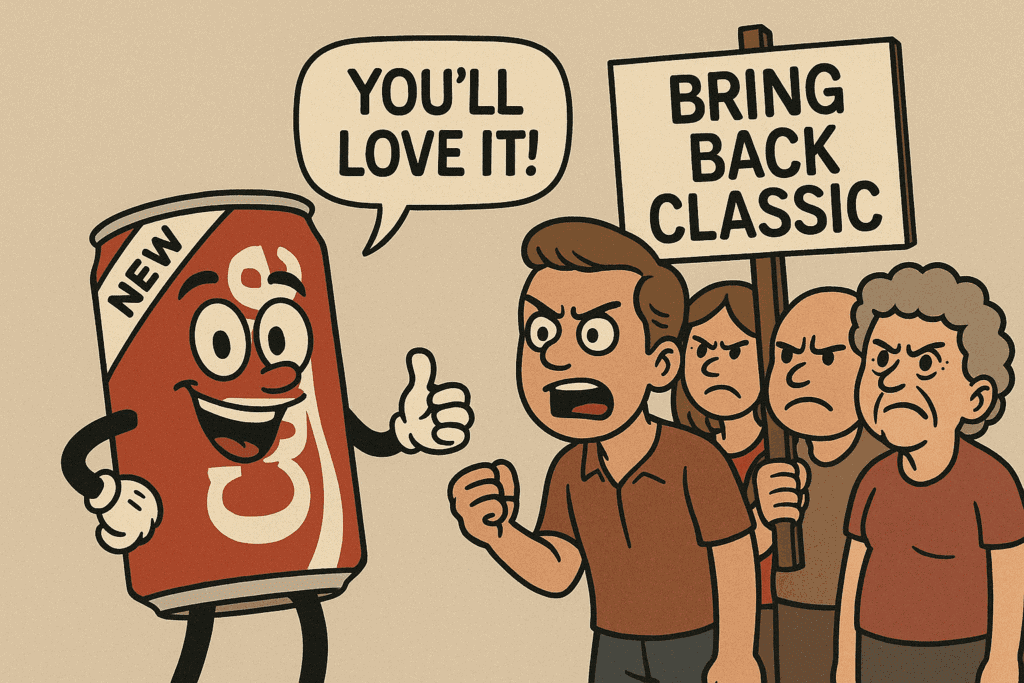Brief Summary

In April 1985 Coca‑Cola replaced its original formula with a sweeter version known as New Coke. The change aimed to regain market share from Pepsi, which had been gaining ground in blind taste tests and consumer preference.
Although the new formula initially tested well, the public reaction was overwhelmingly negative. After just 79 days, Coca‑Cola brought back the original recipe as Coca‑Cola Classic.
This incident is now widely cited as one of the most significant lessons in brand loyalty and the emotional attachment consumers have to legacy products.
Company Involved
Marketing Topic
Product Positioning, Brand Identity, Crisis Response, Consumer Experience
Public Reaction or Consequences
The backlash was immediate and intense. Coca‑Cola’s customer hotline received over 1,500 calls per day, up from 400. Protest groups formed, including the Old Cola Drinkers of America. Letters were addressed to executives with names like “Chief Dodo.” Media outlets and comedians mocked the decision. Even Fidel Castro publicly criticized the move, framing it as a sign of American capitalist decline.
Why It Matters Today
This case underscores how emotional branding can override product logic. It teaches marketers that data from tests and surveys must be weighed against cultural and emotional resonance. In an era where brand decisions are amplified by social media, the lessons from New Coke are more relevant than ever.
3 Takeaways
- Consumer emotions matter more than product features. Functional improvements may backfire if they disrupt brand identity.
- Test results do not equal market readiness. Blind taste tests showed preference for New Coke, but failed to capture the emotional importance of the original formula.
- Own your mistakes and respond quickly. Coca‑Cola’s swift reintroduction of the original formula helped recover its reputation and regain consumer trust.
Notable Quotes and Data
- “The cola category in general was lethargic. Consumer preference for Coca‑Cola was dipping.” — Coca‑Cola executive, History.com
- “By June 1985, the company hotline was getting 1,500 calls a day, compared with 400 a day before the taste change.” — History.com
- “It was, Time declared, ‘like putting a miniskirt on the refurbished Statue of Liberty.'” — Time Magazine
Full Case Narrative
In the early 1980s Coca‑Cola was losing market share to Pepsi, particularly among younger consumers. Pepsi’s advertising campaigns, including the Pepsi Challenge, showcased how people preferred its sweeter formula in blind taste tests. Coca‑Cola launched Project Kansas, a secret initiative to develop a new, sweeter formula to compete directly.
On April 23, 1985, New Coke was introduced. The announcement was backed by taste tests showing that consumers preferred the new formula. Sales initially rose, but emotional backlash quickly followed. Consumers felt betrayed, viewing the change as an attack on tradition. Protest campaigns, media mockery, and fan outrage spread quickly.
Just 79 days later, Coca‑Cola announced the return of the original formula, now branded as Coca‑Cola Classic. The public welcomed it with enthusiasm, and sales rebounded. While New Coke remained on the market for years under the name Coke II, it never achieved significant success again.
The case remains a classic lesson on understanding customer sentiment, brand equity, and how not to ignore the voice of the consumer in pursuit of innovation.
Timeline
- April 23, 1985: Coca‑Cola launches New Coke nationwide.
- May 1985: Consumer backlash escalates. Hotline calls spike to over 1,500 per day.
- June 1985: Protest groups form and public ridicule increases. Editorials, late-night jokes, and political commentary amplify criticism.
- July 11, 1985: Coca‑Cola announces the return of the original formula, rebranded as Coca‑Cola Classic.
What Happened Next?
After the reintroduction of Coca‑Cola Classic, public perception of the brand improved. The company leaned into nostalgia with patriotism-themed ads and celebrity endorsements. New Coke remained on shelves as Coke II until it was quietly discontinued in 2002. Marketers today continue to study this case as an example of how product changes must consider not just performance, but identity, history, and emotional resonance.
One Sentence Takeaway
Even the most researched product launch can fail if it disconnects from the emotional core of your brand.
Sources and Citations
History.com, New Coke debuts, one of the biggest product flops in history, published April 23, 2024.
Encyclopedia Britannica, New Coke overview, accessed June 2025.
The Coca‑Cola Company, New Coke: The most memorable marketing blunder ever?, company history page.
Allrecipes, Coke Classic: The Story of How America Saved Its Favorite Drink, published June 2025.
Time Magazine, Here’s What New Coke Tasted Like, published April 23, 2015.
Food and Wine, We compared New Coke to Coca‑Cola – Here are our thoughts, published June 2019.
